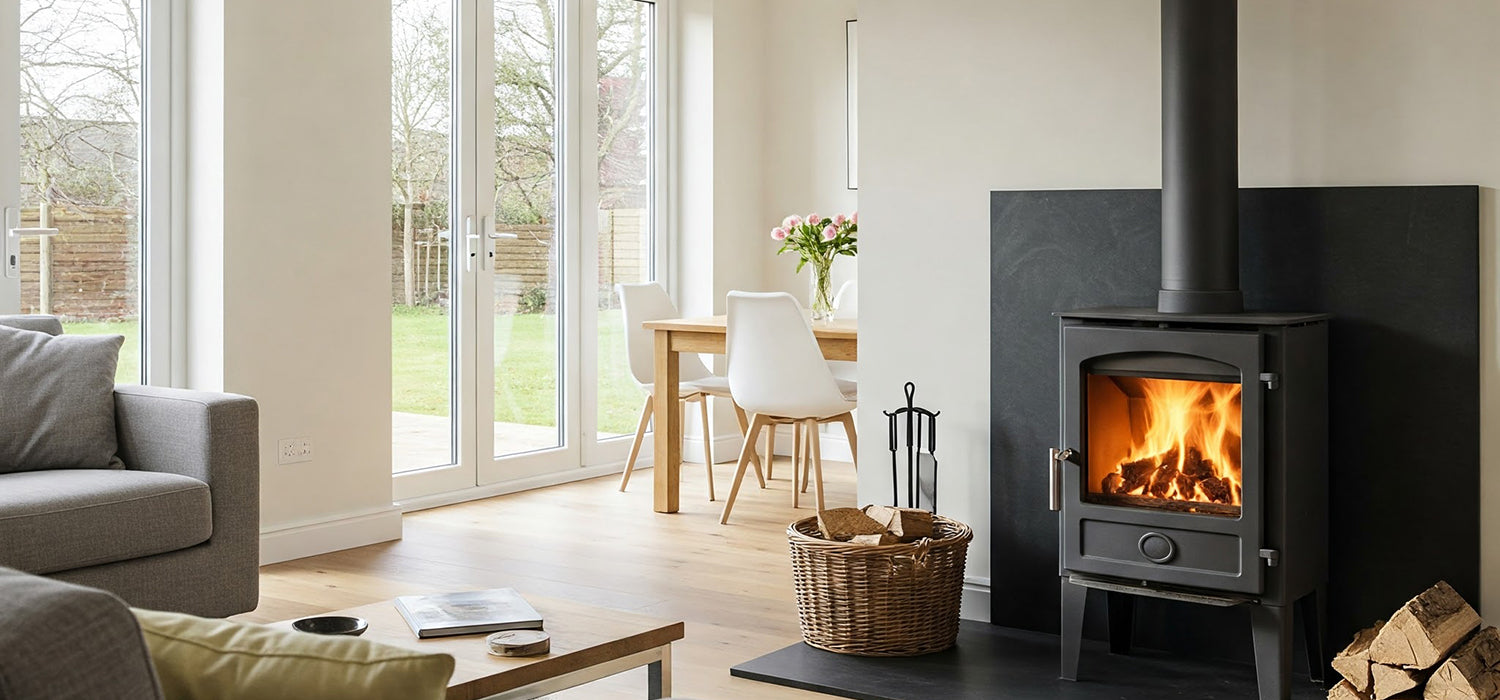
Log Burner for New Build: What You Need to Know Before You Install One
Yes, you can fit a log burner in a new build—but it’s not as easy as plonking it down and lighting a match. From choosing what log burner to buy to dodging building reg pitfalls, here’s how to get cosy (legally!) without setting off alarms—literally.
Planning a Log Burner Installation in a New Construction Project
Installing a log burner in a modern home might seem like a bit of an old-school move—but it’s becoming more popular than ever. And for good reason. There’s something timeless about a real fire that even the fanciest underfloor heating can’t quite replace.
But with new builds being tightly sealed and heavily insulated, there’s a bit more planning involved than there would be in a draughty Victorian terrace. The key? Start early and think ahead.
Integrating the Chimney and Flue System into the Design
Most new-build homes don’t come with chimneys. It’s not a deal-breaker—but it is something to work around. The solution? A twin-wall flue system.
This type of flue can be built into the house design from day one. It’s insulated, safe, and designed to keep flue gases hot enough to exit cleanly. Whether you route it up through the ceiling or out through an exterior wall, planning it early avoids awkward surprises later—like having to carve a flue-shaped hole through your brand-new kitchen.
Some homeowners even turn the flue into a feature, boxing it in with tile or steel for a bold, industrial look.
Compliance with Current Building Regulations
Before you go picturing yourself toasting crumpets by the fire, let’s talk red tape. In the UK, all solid fuel installations must follow Part J of the Building Regulations. These rules apply whether you’re renovating or building from scratch.
In a new build, the key areas to get right are:
-
Adequate clearance from walls and furniture
-
A hearth made from non-combustible material
-
A safe and correctly sized flue
-
Ventilation—possibly the most important bit
-
A carbon monoxide detector in the room
Because new homes are so airtight, your stove needs its own dedicated air supply. Many modern stoves come with a direct air kit, allowing them to draw oxygen from outside rather than stealing it from your lounge. This keeps the burn clean, efficient—and safe.
Choosing an Energy-Efficient and Eco-Friendly Model
When it comes to deciding what log burner to buy, you’ll want to think green as well as warm. The best models today are DEFRA-approved (meaning they can legally be used in smoke control areas) and Ecodesign 2022 compliant.
That’s not just a tick-box thing. Ecodesign stoves are up to 80% more efficient than older models. They use less wood, produce fewer emissions, and leave less soot behind.
It’s better for your chimney, better for your wallet, and—of course—better for the planet.
Benefits of Installing a Log Burner in a New Build
You might be wondering whether all this effort is worth it. The short answer? If you’re after style, warmth, and a backup heat source that doesn’t rely on the grid—it absolutely is.
Let’s take a look at what you gain.
Increased Home Value
A log burner isn’t just a cosy luxury—it’s a smart investment. Estate agents frequently list them as desirable features, particularly in colder or rural parts of the UK.
Many buyers love the idea of having a secondary heating option. Others are sold on the aesthetics alone. Either way, it can add genuine value to your home, especially if installed as part of a well-designed interior.
Alternative Heating Source
If you’ve ever lived through a winter power cut, you’ll know just how handy a log burner can be. When the radiators go cold and the lights go out, a wood-burning stove keeps on chugging—no electricity needed.
It’s especially useful for off-grid homes, or areas where electric heating is pricey or unreliable. Think of it as heating with a built-in Plan B.
Aesthetic Appeal
Let’s be honest—a log burner is about more than just warmth. It’s a vibe.
Whether you’re going for modern minimalism, rustic charm, or full-on cabin chic, a well-chosen stove becomes a focal point. Picture it: a roaring fire, soft lighting, hot drink in hand. It’s the stuff Pinterest boards are made of.
Add a feature wall, a stone hearth, or a few neatly stacked logs, and your stove becomes as much a part of your décor as your kitchen island or feature staircase.
Working with Architects and Builders
If you’re still in the early stages of your build, now’s the perfect time to bring your log burner dreams to life. The earlier you involve your architect or builder, the smoother the process will be.
Specifying Requirements Early in the Planning Process
Bringing up your plans for a stove after the house is plastered is like asking for underfloor heating once the tiles are down—it’s technically possible, but it’ll cost you.
Instead, make your intentions clear from the start. Your builder can plan for things like:
-
Structural supports beneath the stove or hearth
-
Routing for the flue and air supply
-
Fire-safe wall finishes
-
Flue clearance zones through the roof or wall
Early planning also gives you more design flexibility—like choosing exactly where that statement stove will sit in your open-plan kitchen or living room.
A good architect will also help balance form and function, ensuring the stove isn’t just pretty to look at, but actually keeps your space warm and efficient.
Wrapping Up: A Stove That’s Built to Belong
Installing a log burner in a new build is 100% doable—with the right planning. It brings heat, character, and even a bit of rugged independence to a modern home.
Start early, choose a clean-burning, future-proof model, and work with experienced pros who know the ins and outs of Building Regs. Before long, you’ll be swapping screens for firelight and enjoying that unmistakable crackle that only real wood can deliver.
Thinking about taking the next step? Chat to a HETAS-registered installer, share your vision with your builder, and get that log burner on your floor plan. Cosy nights are just a few design decisions away.
Other content we think you'll love
- What Log Burner Do I Need? The Cosy Homeowner’s Guide
- What Log Burner to Buy: The Cosy Homeowner's Guide
- How to Remove a Wood Stove: A Step-by-Step Guide
- How to Fit a Log Burner (Without Setting Off the Smoke Alarm)
- What Size Log Burner Do I Need? A Simple Guide to Finding the Perfect Fit
- Where to Put a Log Burner: Finding the Perfect Spot for Warmth and Style
- Can You Take a Log Burner When You Move? Here's What You Need to Know
- How to Fit a Wood Burner in a Conservatory
- Installing a Log Burner Near a Gas Pipe: What You Need to Know
- Log Burner Near Curtains: How Close Is Too Close – And How to Stay Safe
- Can You Use a Log Burner Without a Liner?
- Can You Have a Log Burner with Underfloor Heating?
- Log Burner Distance from Combustibles: Stay Safe and Warm

